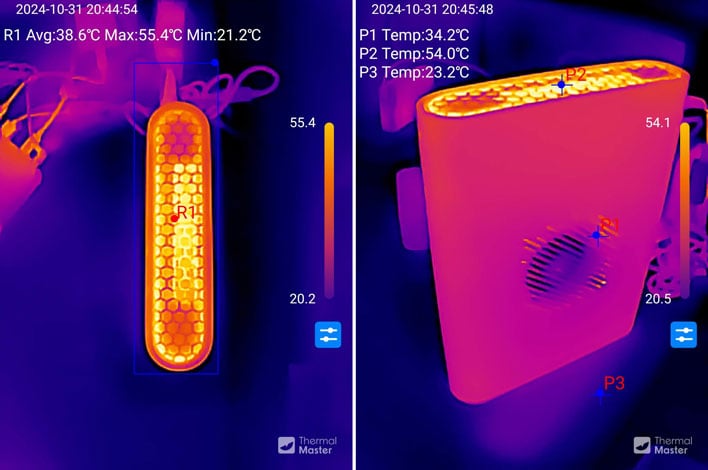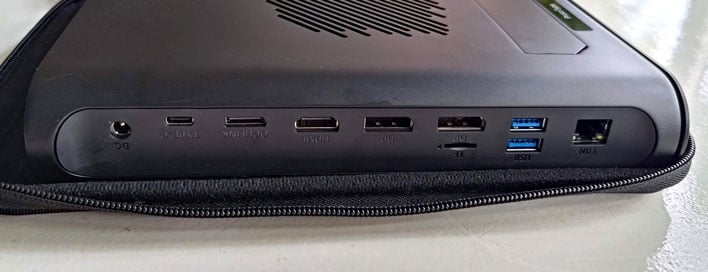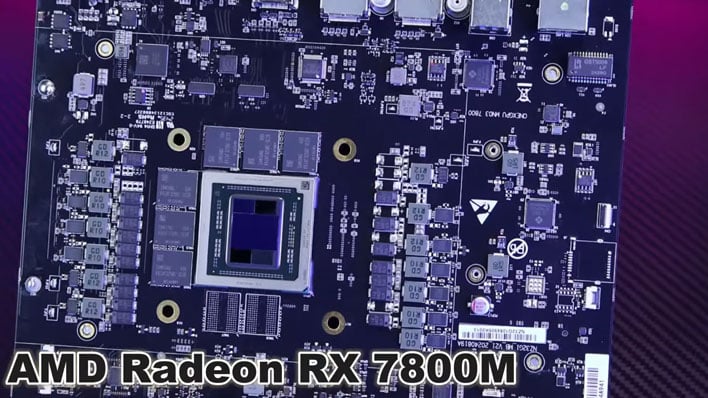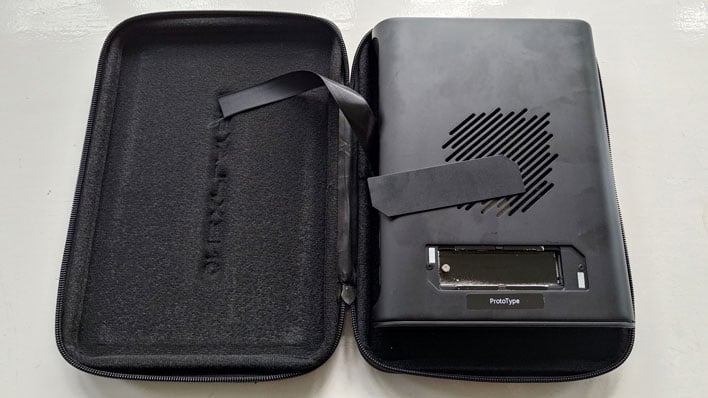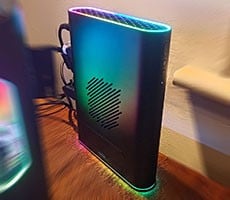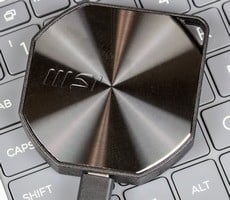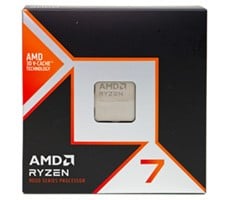OneXGPU 2 AMD Radeon RX 7800M eGPU Review: Thermals, Acoustics And Our Verdict
We have already established that One-Netbook has added substantial mass and bulk in order to make the OneXGPU 2 a thermally and acoustically well-mannered device. The weight of the new gen OneXGPU 2 is almost double its predecessor, at 1.61kg (2.55 lbs) and the volume of the device has gone up from approximately 0.75 to 1.7 liters (but they are both accompanied by the same palm sized 330W GaN PSU). The engineers must have been compelled to ramp up the physical presence of the OneXGPU 2 due to the Radeon RX 7800M's increased TDP and the more capable thermal solution required to cool it.
We could surmise that, even with this more powerful cooling system, this device can sometime produce a fair amount of noise and expel a lot of heat. Noise and heat are even more pronounced when the Radeon RX 7800M is run in its higher-power 180W mode. Temperatures and noise aren't insufferable though, and you can always position the eGPU somewhere further from earshot. All a user must do is make sure the eGPU has room somewhere to stand vertically, allowing the left and right intakes to suck in air uninhibited, and expel warm air from the vented top of this system.
OneXGPU 2 Thermal Profile
Above you can see our thermal camera shots of the OneXGPU 2 when running a demanding game at uncapped frame rates. Both shots show air expelled from the top of the eGPU is warmed to the mid-50°C range. It seems to be quite an effective cooling system with the greatest heat recorded near the top outlet vent, as heat rises. The exhaust positioning seems well thought out and optimal.
Running this eGPU for prolonged gaming sessions can definitely warm up a room a bit. However, in general use, the device remains almost completely silent (in either 130W or 180W mode) and cool.
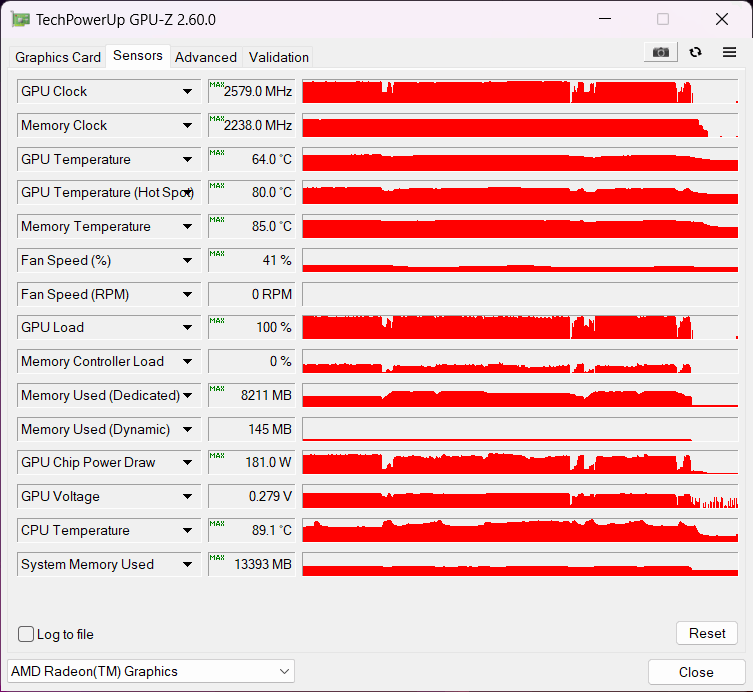
Using a system monitor tool to check the temperature of the Radeon RX 7800M GPU, with games running in 180W mode, we saw a peak GPU temperature of 64°C. However, the GPU hot spot hit 80°C, and the max memory temperature was a toasty 85°C.
OneXGPU 2 Noise Levels
The OneXGPU 2 can ramp up to noticeable noise levels at in its 130W and 180W modes. When the system was under modern gaming loads, the loudest 180W turbo noise level was 47dB, measured with the device at approximately arm's length (70cm) on the desk beside the test system's monitor. System monitoring tools didn't report the fan speeds in RPM, but apparently they never spun-up faster than 44% of their maximum. Similar measurements with the 130W GPU mode selected showed the highest noise levels dropping to 45dB. Looking at the numbers that may appear to be a small reduction, but we could hear the difference. The fastest fan speeds in 130W mode were reported to be 32% of the maximum RPM. Moreover, toggling the turbo button on the device seemed to be accurately reflected in software tools, with the 130W and 180W modes switchable at any time.
We also positioned the OneXGPU 2 under a desk, and it substantially reduced the perceived noise. It would also probably be the best choice for those irritated by the device's RGB lighting. On our test device there was no togglable lighting mode which turned the LEDs off.
OneXGPU 2 Review Conclusion And Final Thoughts
One-Netbook has taken its sleek mobile eGPU design from last year up a considerable notch in performance with the new OneXGPU 2. Rivals like Minisforum and Ayaneo are still launching Radeon RX 7600M XT-powered devices, but the GPU specs of this device are considerably more impressive. In our tests, we saw worthwhile increases in performance on the systems we tested, which were otherwise stuck with integrated or other less powerful GPUs.
The OneXGPU 2's Radeon RX 7800M handled everything we threw at it, gaming in high or ultra settings at 1440p with ease. Thus it could be a great upgrade for those who are want to stick with their current laptop, mini PC, or handheld, which may be underpowered in the 3D graphics department, but adequate in other ways.
A single USB 4 cable connection option offers a compelling 3D acceleration boost for the Geekom A8 mini PC we tested it with, with the added bonus of convenient docking functionality. We also saw the greater potential that an OCuLink interface could provide, with the Megamini G1 tests. However, we must remind readers that OCuLink users will have to also plug in a USB-C cable to get the docking functionality, to enable Ethernet and SSD expansion.
The higher-powered Radeon GPU upgrade here has had quite an impact on the size and weight of this device, but it remains far more portable than 'traditional' eGPUs from companies like Razer or Gigabyte Aorus, which are basically put together using a small chassis and PC-class PSUs and desktop graphics cards (with slower interfaces). However, with a portable eGPU solution like this, you can't swap out the GPU to upgrade in the future.
In its favor, the OneXGPU 2 should be a decent performer for several years with its beefy GPU and 12GB of VRAM. Considering the PC connections for a moment, it is good to see OCuLink and experience the benefits it delivers, but the design of the connector feels a bit flimsy (we had two cables from two sources). The OCuLink connector standard has nothing to do with One-Netbook, but the plug feels pretty flimsy compared to others like HDMI and DP, or even USB-C.
Another thing which may hold back users from eGPU adoption in late 2024, is that we are on the cusp of the rollout of Thunderbolt 5. It has just started to arrive in mainstream consumer devices like the new M4 Apple Macs. There's also a Razer Blade laptop with Thunderbolt 5. Going forward, we reckon Thunderbolt 5 may be a much better single-cable interface for eGPUs and high performance docks, easily beating both USB4 and OCuLink in throughput by offering 80 to 120Gbps of bandwidth.
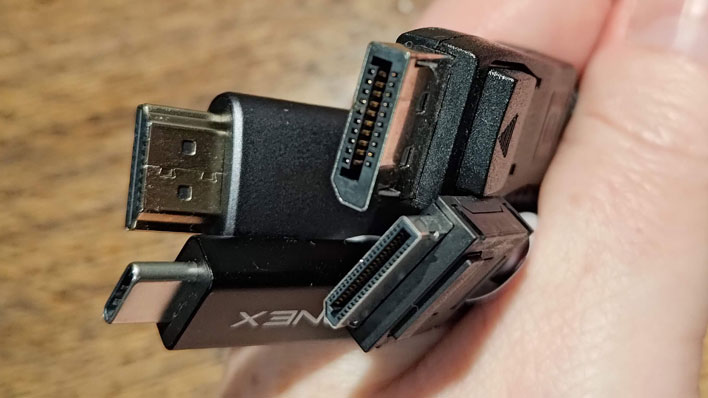
The OCuLink connector (bottom right) isn't as rigid or strong as the others
One-Netbook stressed that the sample we tested is a prototype, so what we tested could be subject to change somewhat in retail devices. Performance and features should carry through to the production models though, in line with the crowdfunding promises. However, our prototype run apparently had an OCuLink connection issue, which the company said required end-users to be very firm when plugging in this cable. We didn't experience any OneXGPU 2 specific OCuLink connection problems, though.
Our model came with both an OCuLink and USB4 cable for testing, as well as the case for transportation. We are told retail units will arrive in fancier packaging, with the same 330W GaN PSU we used, a region-appropriate plug, and a USB4 cable. Not everyone will want or need the OCuLink cable or carry case, which are modestly priced extras, however.
Potential buyers have a lot to consider. The OneXGPU 2 isn't cheap, with its price at the time of writing set at $999. That's several hundred dollars more than RX 7600M XT-packing rivals, which can start at around the $600 level. The premium price is probably the major drawback of this product, more so than any concerns of newer eGPUs with faster Thunderbolt 5 interfaces and devices around the corner. Some early bird crowdfunding backers managed to secure these units for $839, which indicates that there should be room for discounts from the current $999 level, once bleeding-edge portable eGPU enthusiasm dampens and availability ramps, or if it's featured in high-profile sales events like Black Friday. So, keep your eyes peeled.

